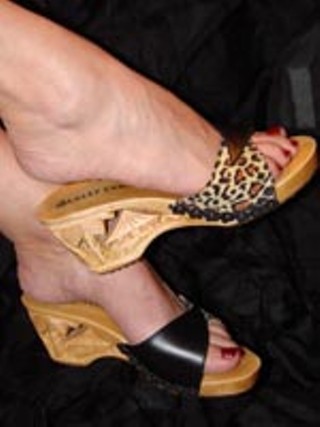Notes on Kitsch
... or W.W.S.S.T. (What Would Susan Sontag Think) about Austin's love of camp?
By Kate X Messer, Fri., Dec. 8, 2006

Was It Grandpa or Snoopy?
"I never really thought about it," laughs Linda Lou Von Hochtritt, the designer and purveyor of Lucky Lou Shoes, a company run out of her South Austin home office, from where she ships vintage-inspired shoes all across the globe and sometimes onto the tootsies of the rich, hot, and famous.
"Why am I so 'into' the Forties? Well, my grandfather was a pilot for the Luftwaffe before surrendering to the Brits in World War II," she reveals. "But when I was little – late Sixties, early Seventies – I was really into Snoopy. I loved when he fought the Red Baron. Granted, that was supposed to be World War I."
Somehow for Von Hotchtritt, decades later, Snoopy's and Grandpa's adventures morph together to inform her aesthetic sensibilities.
"I came across my first pair of Bahuykabo or 'souvenir shoes' for $3 in 1994 on the streets of San Francisco where some homeless guy was selling found items," Von Hochtritt remembers. These original "souvenirs" were made in the 1940s by native carvers in the Pacific and made popular stateside by soldier boys eager to impress their intended. "I had no idea they were from World War II. I just loved them and wanted to know where to get more. So I began doing research."
Her search paid off when she found the carvers – the grandchildren of the original artists who popularized the style in the 1940s – practicing the art today and negotiated to work with them to develop a line of shoes, near-replicas of a raging style from another era.

Boutiques across the U.S. and Europe now carry her lines of tiki tropicalia. The sassy wooden souvenirs have found their way onto the arches of Charmed's Rose McGowan; the Black Eyed Peas' lead lady, Fergie; and über rocker mama Gwen Stefani.
The shoes appeal to a certain sensibility: For some, they are trips back to the postwar boom, and for others, they fit right into recurring lounge and exotica revivals. It's easy to associate the look with Martin Denny, mai tais, and Yma Sumac. But fans of rockabilly and drag-race culture (think: Ed Roth and Rat Fink, not NASCAR) have tapped into the look as well.
How does that work? Why do certain kitschy artifacts hold such sway with certain groups? Why, for example, are some people "into" collecting ceramic chickens (totally ridiculous) or owls (okay, I can relate), for example?
Back in 1964, culture critic Susan Sontag wrote the landmark piece "Notes on 'Camp,'" exploring the nature of American culture to fetishize and endear material artifacts. As opposed to a dry academic treatise, Sontag's piece flits and floats around a variety of concepts, playfully putting into context our affection for crap: "Camp taste is, above all, a mode of enjoyment, of appreciation – not judgment. Camp is generous. It wants to enjoy. ... People who share this sensibility are not laughing at the thing they label as 'a camp,' they're enjoying it. Camp is a tender feeling."
LuCretia Sisk, owner and manager of Room Service Vintage, which has been outfitting Austin with delightfully tacky trinkets and postwar pop cultural aesthetics from their North Loop location for 25 years, laughs. "Every week we hear some customer get real excited, 'Dude! Duuuuude! I used to have this!' And it will be some totally common, mass-produced thing, obviously with some nostalgic appeal as opposed to antique-y value."
"That's less true for the home-furnishing aesthetic," says fellow store dealer Lori Goodpasture. "Say you are drawn to a certain lamp. It's usually because you like a certain style, like midcentury modern, for its lines, not because you literally had it as a kid."
Sisk elaborates, "We are selling nostalgia more than kickass records, for example." She remembers when her boyfriend, record collector Eric Lord began as a dealer at the store and sniffed at a Brady Bunch LP. "I had to break it to him that that's not how things work around here. It's not like the regular serious record-collecting world. It's fun, it's funny. Someone would totally buy it, not for it's value but for what it means to them."

Sisk and Goodpasture deal in everything from gorgeous Heywood-Wakefield dining sets, festive spaghetti lamps, and black jaguar TV mascots to 90210 and NKOTB swag. "My goal," says Sisk, "is not to have a museum here. It's about turnover and nostalgia."
"That's why she's the queen of vintage," Goodpasture laughs. "Who knows how people's tastes come about? I'm always asking myself what makes somebody listen to country music."
"What's also interesting," says Lucky Lou's Von Hochtritt, "is how taste and interpretations of it change.
"I was talking to Prince from Atomic City [which carries Lucky Lou shoes] about life in the Fifties. When he was growing up, wife beaters and leather jackets were not the fashion. Nobody had that stuff." We can thank the kitschy shorthand by TV shows like Happy Days for promoting such misleading memories.
"Take for example rockabilly: Have you noticed how it went from poodle skirts and saddle shoes to corsets and tattoos? Most women didn't have tattoos in the Fifties."
Certainly a love of kitsch – the byproduct of its attendant sensibility, camp – is the product of lots of leisure time. According to Sontag, there is a relation between boredom and camp taste, which is, "by its nature possible only in affluent societies capable of experiencing the psychopathology of affluence." (Some might argue that this type of pop-culture analysis falls under a similar purview.)
Is it possible to revel in the cultural detritus of pop sensibilities, to wallow in rubber duckies, to scour the globe for Gorillaz action figures, to get giddy over gnome knickknacks and still be aware of the sometimes complicated and messy triggers for such impulses?
Like our old pal Sontag says, "It's embarrassing to be solemn and treatiselike about Camp. One runs the risk of having, oneself, produced a very inferior piece of Camp."
With that, dear readers, we invite you to venture out yourselves and explore the treasure troves of American excess, of stuff, of junk, of kitsch, of crap, right here in Austin. Then write your own paper. ![]()








